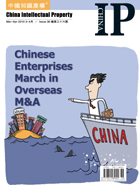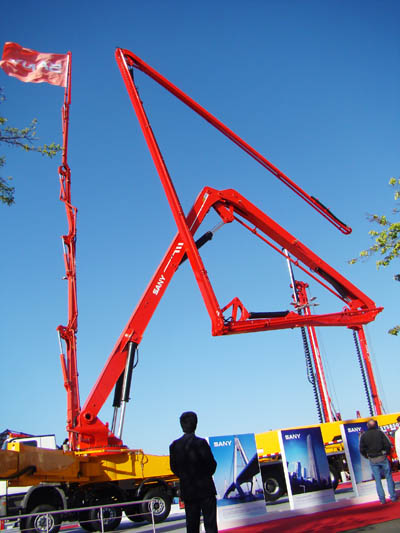

On October 23, 2009, the High Court of Justice rendered a judgment in the trademark dispute of Daimler AG vs. Sany Group, deciding that the registration and use of the trademark of Sany Group did not constitute an infringement upon Daimler AG’s Mercedes-Benz Star logo. Thus, this nearly one-and-a-half-year-old international trademark litigation in the UK was finally put to rest.
“We firmly believe that Sany Group’s victory owes to the distinctiveness and rich cultural deposits of the company’s trademark. This is why we dared to confront a world’s Fortune 500 company in court,” said Ren Yulong, legal advisor to the Sany Group.
However, Sany Group’s victory in the UK does not mean that the company can finally breathe a sigh of relief. The global trademark controversy between Sany Group and Daimler AG has existed for a long time and will probably resurface in the future. Daimler AG’s withdrawal of the action in the UK possibly sowed the seeds of its future proceedings against its opponent.
Embroiled in a controversy unexpectedly
Sany Group was founded in 1989. Its figurative mark is comprised of an unclosed circle and three Arabic numeral “1” inside, which stands for the culture and mission of Sany Group: to establish a first class company, to cultivate first class talents and to make first class contributions to society.
Mr. Ren told this journalist: “Our trademark was designed in the 1980s by a high school art teacher from Loudi City of Hunan Province, where our company was formerly located.”
In the late 1980s, a Chinese enterprise used a figurative mark to express its ambition of, “being first class”. Unexpectedly, this trademark came to the attention of Daimler AG Germany, which claimed that Sany’s trademark was a mimic of their Mercedes-Benz Star logo.
When Sany Group filed an application for the registration of its figurative mark with the China Trademark Office, Daimler AG raised an objection, arguing that Sany’s trademark fraudulently copied its Mercedes-Benz Star logo. However, in the presence of Sany Group’s evidence, Daimler AG’s arguments were found untenable and the trademark was finally registered successfully.
The initial conflict was just a prelude to the two companies’ time-consuming trademark controversy. Sany Group set its target to become globalized and to become world-class. However, before the group had even set foot in the global market, Daimler AG had already registered its Mercedes-Benz Star logo in more than 100 countries.
Sany Group began its international business expansion in 2002, and in the process applied for trademark registration in countries all over the world.
Sany Group was also mentally prepared for Daimler AG’s “trouble-making”. “With the experience of Daimler AG’s previous disturbance, we were fully aware of the possible hindrance to our overseas trademark registration. To this end, we employed Unitalen Attorneys At Law, a famous trademark registration agency form Beijing, to design the overseas registration schemes for us, and appointed the best foreign law office to respond to Daimler AG’s objections and actions,” said Ren.
But Daimler AG did not back off. The German Company closely followed Sany Group’s worldwide registration pace and raised a total of more than 50 objections. The global trademark controversy between Sany Group and Daimler AG had officially started.
According to Du Yanxia, trademark attorney for Unitalen Attorneys At Law, Daimler AG used different strategies for the litigations in different countries. For example, in Germany, where trademark registration system is identical with China’s, the German company simply made an objection to the German Patent and Trade Mark Office (DPMA).
“Administrative review is quite different from judicial review. The former simply examines whether two trademarks are proximate; and the latter usually conducts all-round examinations in combination with market reactions. Therefore, although Sany Group's figurative mark and Daimler AG’s Mercedes-Benz Star logo are totally different in terms of connotations, they do share design proximities. Daimler AG just took this advantage and won trademark opposition lawsuits in many countries. For example, the two trademarks are deemed similar in Germany, but dissimilar in Class 7 (machines and machine tools) and similar in class 12 (vehicles) in France,” said Du Yanxia. “However, Sany Group is still entitled to use the word mark in those countries.”
“For those countries in which the registration failed, we will continue using all kinds of remedial measures to have the trademark successfully registered," said Ren.
Sany Group applied for trademark registration in the UK in mid 2006 and Daimler AG raised the objection as usual after the review period expired. However, the German company was a little bit too impatient this time, for it took Sany Group to court before the trademark opposition had concluded.
Winning the suit in UK
In May 2008, when Sany Group was preparing for the Super Eight Demonstration (SED), Daimler AG sent a lawyer’s letter, demanding that Sany Group stop using its figurative mark in the demonstration. It also applied to the High Court of Justice for an “interlocutory injunction” of the mark on the grounds that Sany Group’s figurative mark was engaged in an ongoing infringement, and irrevocable loss would be incurred by Daimler AG should Sany Group continue using the figurative mark in the demonstration. Based on a lack of evidence, the Court rejected Daimler AG’s request. To be on the safe side, Sany Group covered or took off the figurative mark during the demonstration.
The “interlocutory injunction” application was just a start. When Sany Group was busy with the demonstration, Daimler AG instituted an infringement action in the High Court of Justice, claiming: (1) Sany Group’s figurative mark was confusingly similar to Daimler AG’s Mercedes-Benz Star logo, and the registration and use of Sany Group figurative mark constituted an infringement; (2) Sany Group’s figurative mark imitated Daimler AG’s Mercedes-Benz Star logo; (3) Sany Group’s figurative mark was an illegal capitalization of Daimler AG’s Mercedes-Benz Star logo.
After receiving Daimler AG’s statement of claim sent by the Court, Sany Group reacted with swift and effective responses. “As opposed to some enterprises, which cower back in safeguarding their own rights when involved in an international lawsuit, we immediately entrusted Unitalen Attorneys At Law, our trademark registration agency, to respond and submit a written defense. We also filed a counterclaim in the Court, seeking to revoke the registration of the Mercedes-Benz Star logo for some of the designated commodities. Then we began the evidence collection work. I calculate that we submitted a total of nearly one thousand pages of evidentiary material bound by six big folders,” Mr. Ren said.
However, it has never been an easy thing for a Chinese enterprise to confront a big foreign enterprise. Firstly, Chinese enterprises are not fully acquainted with the British procedural law system and it is difficult predict the chances of winning, which certainly has a negative effect on the legal proceedings. Secondly, in common law countries, evidence and lawyers are the two most important factors in litigation, but finding a satisfactory legal team is by no means easy for Chinese enterprises. Thirdly, litigation cost is very high. According to an official from Sany Group, the lawyers’ appearance fee during the final court trial period alone cost more than 700,000 pounds.
“Cost is not a big deal at all. Sany Group would not have answered the lawsuit if it cared too much about the cost,” said Mr. Ren. “The biggest obstacle is our inexperience and lack of understanding of foreign laws.”
With the help of Unitalen Attorneys At Law, Sany Group entrusted a famous local law firm in Britain and organized a competent legal team.
In December 2008, Daimler AG made another move. It applied a motion to the court for summary judgment, a procedure by which the court may render a decision based on the statements and evidence presented for the record without a trial, but only if the court determines that there are no factual disputes to resolve. In this case, the result would have been that the court would have summarily ruled against Sany Group on the grounds that the stipulated facts and evidence constitute infringement per se. If the court made such a ruling it would have ordered Sany to assume the relevant legal responsibilities and remedies without a trial.
Sany Group made a swift response the following month and submitted the written defense and relevant evidence and testimonies. Thanks to the Group’s persistent efforts, the Court finally ruled on May 14, 2009, that summary judgment did not apply to this case. Daimler AG lost the motion.
Then the case went to formal trial. According to the British procedural rules, both parties must submit sufficient evidence and testimonies to substantiate their case. “I seemed to be fighting in a real war in those days!” said Ms Du. As the Chinese attorney agent, she buried her head in collecting the evidence submitted by Sany Group and coordinating with British lawyers.
The trial was held from July 6 to the 10, 2009, during which Daimler AG withdrew its first and second claims. Ms Du gave the reason: During evidence exchange, Sany Group had presented abundant evidence and Daimler AG predicted the dim chance of winning the case, and therefore withdrew two relatively significant claims in order to lodge further complaints against Sany Group.
On October 23rd, 2009, the Court made a ruling on the third claim: Daimler AG’s claim was rejected; Sany Group’s registration and use of its figurative mark did not capitalize on Mercedes-Benz Star logo.
Lawsuits encourages innovations
The trademark fight in the UK ended in victory for Sany Group. Ms. Du concluded that, “Sany Group is an enterprise with strong trademark awareness. Their perspectives of trademarks and business development enjoy a good lead. Some enterprises are hindered by the high trademark registration fee in foreign countries, but Sany Group registers its trademark worldwide. Besides, to maintain the market order, it fights against the international business giants fearlessly.”
The main credit for Sany Group’s victory attaches to the profound corporate culture of the group and its trademark distinctiveness. Daimler AG’s withdrawal of two claims is a further proof of this. “Sany Group is also an influential enterprise, which was an important factor for judicial consideration when examining Daimler AG’s third claim. They had to put market reactions into account and compare the strength of the two companies. Sany Group had provided sufficient evidence to prove the distinctiveness of its trademark, and also revealed its strength through commercials, product popularity and the experiences of attending demonstrations. After a comprehensive consideration, the judges ruled in Sany Group’s favor,” said Du.
The lawsuit in the UK is over, but trademark opposition in this country has not come to an end and we don’t think Daimler AG will back down in its obstinate obstruction of Sany Group’s globalization course.
“The lawsuit did not have any severe impact on Sany Group’s development strategy or brand strategy. On the contrary, it strengthened our confidence in establishing a first-class international enterprise and building our own brands with proprietary intellectual property rights,” said Ren.
(Translated by Hu Xiaoying)
|
Copyright © 2003-2018 China Intellectual Property Magazine,All rights Reserved . www.chinaipmagazine.com 京ICP备09051062号 |
|
|



